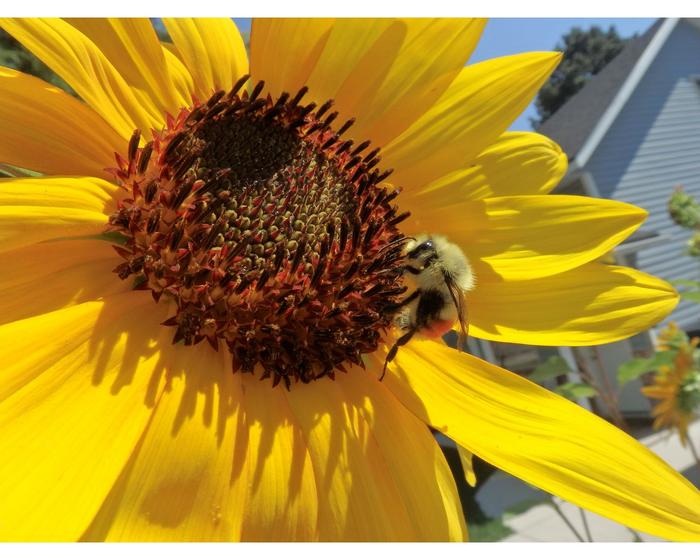TORONTO, May 22, 2024 – Community science volunteers – laypeople with an interest in bees and conservation – significantly contribute to the scientific knowledge of native bumble bees across Canada and the United States, finds a new study by York University.

Credit: Victoria MacPhail
TORONTO, May 22, 2024 – Community science volunteers – laypeople with an interest in bees and conservation – significantly contribute to the scientific knowledge of native bumble bees across Canada and the United States, finds a new study by York University.
It’s buzz worthy confirmation that community science programs can play an important role in monitoring the changing distributions of bumble bees and more. Community scientists have importantly also detected several at-risk or endangered species in unexpected locations, including the rusty-patched bumble bee and the gypsy cuckoo bumble bee. Trained scientists often haven’t seen some of the bees in years and these sightings can help them keep tabs on the species.
The paper, Bumble Bee Watch community science program increase scientific understanding of an important pollinator group across Canada and the USA, was published today in the journal PLOS ONE.
Up to a third of North American bumble bees are in decline, but the why of it is still fuzzy. Knowledge gaps about bumble bee stressors, ranges, population dynamics and preferred plants are prevalent.
“As scientists we really value the contribution of community scientists and the breadth of data they are able to gather, including a wide range of locations and species. As scientists usually lack the resources and time to do this kind of field work over such a large geographic area, it really shines a spotlight on the importance of community science programs,” says lead and corresponding author Victoria MacPhail, who conducted the research as part of her PhD at York’s Faculty of Environmental and Urban Change (EUC).
Through the growing Bumble Bee Watch (BBW) program, community scientists have been the eyes on the ground for bee researchers. The volunteers have taken photos of bumble bees from every province, state and territory and upload them through the BBW website along with where they were spotted and plant information if known. Bee taxon experts verify the species of bee.
“The data collected by volunteers through Bumble Bee Watch was surprisingly more plentiful, robust and valuable than anticipated and we rely on that data to add to our current knowledge and to confirm other information,” says MacPhail, who is also a former Bee Ecology, Evolution and Conservation coordinator at York.
MacPhail completed the study along with York Associate Professor Sheila Colla of EUC and Senior Endangered Species Conservation Biologist Richard Hatfield of the Xerces Society for Invertebrate Conservation in the United States. They compared BBW data collected by community scientists with the Bumble Bees of North America (BBNA), data collected through traditional scientific methods, for all years available and specifically from 2010 to 2020.
The researchers found the BBW covered as much ground geographically, as the BBNA over all years – 63 provinces, states and territories – and had information on 41 species compared to 48 in the BBNA.
Looking exclusively at the decade from 2010 to 2020, the BBW had data from an additional four provinces and states, and more information about 13 species than in the BBNA.
In terms of percentages, the BBW contributed 8.5 per cent of overall records, but that increased to more than 25 per cent during the specific decade being studied. Community scientists were able to confirm the prevalence of species as well as inform researchers of which species were inhabiting new locations.
They also contributed ecological information, such as species data for most of the bee species and unique plant genera. Knowing which flowers different types of bumble bees prefer is nothing to sneeze at as it can help prevent habitat loss and inform conservation management.
“While the BBW had fewer bee records than the BBNA database overall, it definitely helps to fill in data gaps and provide new information, and it complements traditional scientific methods,” says Colla. “We found the BBW to be valuable as it bolsters our knowledge about habitat, species associations, distribution, and changes in population size, which helps to inform conservation management for bumble bees.”
In addition, community science programs can bring awareness to the threats facing bumble bees and help mitigate species decline as they are already interested, engaged and documenting bees, their habitats and their locations – buzz pollinating action and ideas.
###
York University is a modern, multi-campus, urban university located in Toronto, Ontario. Backed by a diverse group of students, faculty, staff, alumni and partners, we bring a uniquely global perspective to help solve societal challenges, drive positive change and prepare our students for success. York’s fully bilingual Glendon Campus is home to Southern Ontario’s Centre of Excellence for French Language and Bilingual Postsecondary Education. York’s campuses in Costa Rica and India offer students exceptional transnational learning opportunities and innovative programs. Together, we can make things right for our communities, our planet, and our future.
Media Contact:
Sandra McLean, York University Media Relations, [email protected]
Journal
PLoS ONE
DOI
10.1371/journal.pone.0303335
Subject of Research
Animals
Article Title
scientific understanding of an important pollinator group across Canada and the USA
Article Publication Date
22-May-2024




